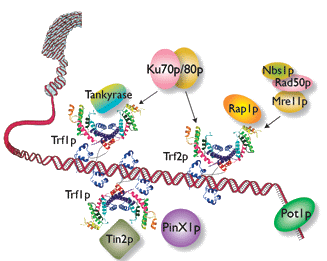

Our goal is to understand how the structure of chromatin is involved in transcriptional regulation and how the tips of chromosomes, the telomeres, are involved in preserving chromosome integrity. Our research focuses on two problems: the higher order structure of chromatin, and the structure of telomeres.
Cellular processes involving DNA encounter the DNA primarily packaged into nucleosomes and higher order chromatin structures.
 We are focussing on determining the three-dimensional structure of the first level of folding of nucleosome arrays, and how this folding is modulated by histone modifications involved in transcriptional regulation.
We are focussing on determining the three-dimensional structure of the first level of folding of nucleosome arrays, and how this folding is modulated by histone modifications involved in transcriptional regulation.
Telomeres prevent the activation of DNA damage checkpoints, regulate the activity of the telomerase and are involved in both cellular senescence and carcinogenesis.
Telomeres are specialized protein-DNA complexes consisting of telomeric DNA repeats and a number of different associated proteins. The main thrust of our research is to elucidate the three-dimensional structure of the protein-DNA and multi-protein complexes of human telomeres to give insights into their precise function.
Selected Papers
- Paeschke, K., Simonsson, T., Juranek, S., Rhodes, D. and Lipps, H.J. (joint corresponding author) (2008)
Telomerase recruitment by the ciliate telomere end-binding protein TEBPb facilitates G quadruplex DNA unfolding.
Nature Struc Mol Biol 15: 598-604 - Routh, A.L., Sandin, S. and Rhodes, D. (2008)
Nucleosome repeat length and linker histone stoichiometry determine chromatin fiber structure.
Proc Natl Acad Sci USA 105: 8872-7 - Robinson, P.J.J., Fairall, L., Huyhn, V.A.T. and Rhodes, D. (2006)
EM measurements define the dimensions of the “30nm” chromatin fiber: Evidence for a compact interdigitated structure.
Proc Natl Acad Sci USA 103: 6506-6511